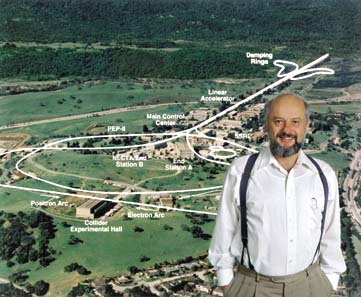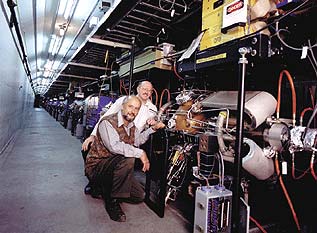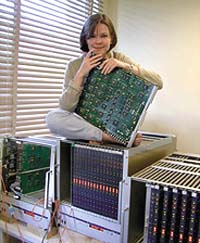 |
High energy physicists are the gophers of the scientific world, they love to make tunnels," says Berkeley Lab's Pier Oddone. The B Factory at SLAC includes a tunnel more than a mile around for the storage rings, and a two-mile long tunnel for the linear accelerator.
"We developed the concept of the asymmetric B Factory by a combination of inspiration and perspiration"
-Pier Oddone
|
|
 |
Existential philosophers are not the only ones who ask: Why are we here? Physicists and cosmologists have the same question. If the Big Bang theory of creation and the Standard Model of physics are true, then, in the aftermath of the vast explosion that started it all, the released energy should have congealed into equal or symmetric amounts of matter and antimatter. These mirror-image particles would have quickly annihilated one another in bursts of energy, according to Einstein's famous E=mc2 equation, creating a universe void of stars, planets and us.
Obviously, this was not the case.
So far as we know, the universe today is essentially absent of any antimatter save for the tiny bits we create in colliders (colliding beam particle accelerators). From out of the Big Bang there must have emerged a preference for matter. The imbalance that resulted from this favoritism did not have to be much to produce our universe-as little as one excess particle of matter in every billion pairs would have done the trick. But was this imbalance a lucky accident or was it the product of a natural asymmetry that ever so slightly tipped the scales in favor of matter?
Eschewing the need for luck, physicists believe the answer lies in an asymmetry that arises from fundamental differences in the way unstable particles of matter and antimatter "decay"-break down into other, more stable, particles. What's more, they now have the accelerators they need to test these differences, thanks to the vision of physicist Piermaria Oddone, who since 1990 has been Deputy Director of Berkeley Lab.
It was at a workshop on the UCLA campus in 1987, while he was director of Berkeley Lab's Physics Division, that the Peruvian-born, MIT- and Princeton-educated Oddone first suggested the best way to look for asymmetry between matter and antimatter would be with an asymmetric collider of electrons and positrons (anti-electrons). This represented a radical break with tradition, in that electron-positron colliders had always been designed to smash together beams of equal energies. But Oddone argued that colliding electron and positron beams of unequal energies would make it possible to study a breakdown in matter/antimatter symmetry known as "CP violation." The study would be done through measuring the decay of a rare particle that is itself a mix of matter and antimatter. This particle is called the B meson.
"We developed the concept of the asymmetric B Factory by a combination of inspiration and perspiration," Oddone says. "The initial idea was more like a flash . . . gee, if we could collide asymmetrically then . . . But colliding asymmetrically with a high rate of events is tough."
Oddone's technical challenge was eventually met in the form of two new electron-positron colliders which come on-line this year. These new colliders have been dubbed "B Factories" because they are specifically designed to produce millions upon millions of B mesons. One is located in Japan and the other is in California at the Stanford Linear Accelerator Center (SLAC).
The United States' version is officially called the "Asymmetric B Factory," and it is a $177 million joint collaboration between three U.S. Department of Energy national labs-SLAC, Berkeley Lab, and the Lawrence Livermore National Laboratory (LLNL)-under the direction of SLAC physicist Jonathan Dorfan.
As we move into the next millenium, this new machine, along with its Japanese rival, is expected to not only shed new light on the birth of the Universe, but to also present the stiffest challenge yet to the Standard Model, the bedrock theory upon which stands our understanding of the fundamental particles and forces of nature.
"The Standard Model will be put in a straitjacket because the pattern of CP-violation is well prescribed. Any deviations and we have new physics."
|
Since its inception in the 1970s, the Standard Model has proven remarkably durable, but there is a concern: the theory can accommodate some violation of CP symmetry but not enough to account for the existence of our Universe. Does this mean the Standard Model is in need of a major upgrade or minor tweaking? The answer may lie in the decay of electrically neutral B mesons (B°) and anti-B° mesons.
The Standard Model holds that the fundamental constituents of matter consist of six quarks and six leptons, each of which comes with an anti-matter counterpart. Leptons are stand-alone particles such as electrons and neutrinos. Quarks never exist alone but combine into composite particles. Ordinary matter-protons and neutrons-is a composite of three quarks, made from combinations of "down" and "up" quarks that do not break down into anything else. Mesons are a union of one quark and one antiquark that swiftly decays to stability through hundreds of various pathways, or "channels."
B° mesons consist of a "down" quark and an anti- "bottom" quark (a massive and exotic beast). Anti-B° mesons (also known as B°-bar mesons) are the reverse; a bottom quark bound to a down anti-quark. As B° and B°-bar mesons decay to stable products, it may be possible for the Standard Model to explain how CP symmetry could be violated at some point along the way. The "C" in CP symmetry stands for "charge conjugation," which simply means that a particle of matter and its antimatter counterpart have opposite electrical charges. The "P" stands for physical "parity," meaning that a particle and its anti-particle are mirror images of one another flipped upside down.
By mass producing B° and B°-bar mesons and looking for discrepancies in their decay, scientists may find that the pattern of CP violation does not fit the Standard Model. This could mean that new theories are required and might also yield new insight into how and why quarks are always bound together.
"The breadth of the attack that these asymmetric B Factories will make on CP-violation is unequalled," Oddone has said. "The Standard Model will be put in a straitjacket because the pattern of CP-violation is well prescribed. Any deviations and we have new physics."
 |
|
Pier Oddone, Deputy Director of Berkeley Lab, and Jonathan Dorfan, director designate of SLAC, pose near a radio frequency cavity that powers electrons circulating in the B Factory's asymmetric rings. |
|
 |
The B Factory at SLAC collides a beam of electrons at an energy of 9 GeV (billion electron volts) and a beam of positrons at 3.1 GeV. An electron-positron collision yields an "upsilon 4S" particle which immediately decays into B and B-bar mesons. Within two trillionths of a second, these matter/antimatter B particles themselves decay into a menagerie of other charged and neutral products.
Were the energies of the colliding beams to be equal, the newly created B particles would remain nearly stationary before they decayed, making it all but impossible to study any discrepancies between matter and antimatter. Under Oddone's asymmetric scheme, however, when the two beams collide, the B particles are carried downstream (about a quarter of a millimeter or one hundredth of an inch) in the direction of the higher energy beam. This forward motion separates the B° and B°-bar mesons, allowing scientists to observe possible inequities in their decay that favor matter over antimatter.
"The fact that the B° and B°-bar mesons are themselves decay products of the upsilon 4S in a well-defined quantum state allows us to use neat tricks to identify the B° and B°-bar mesons individually," says Oddone. "We are now poised to study a wide array of B° and B°-bar decay channels independently and measure any differences in their respective rates."
Another advantage of an asymmetric collider is its ability to maintain high "luminosity"-a measurement of the rate of particle collisions, Oddone says. "This is a natural consequence of having two rings with many particle bunches, something not possible to do in a symmetric single ring machine."
Because the decay of any B particle is a rare event, tens of millions of B/B-bar pairs must be produced in order to obtain statistically significant data. The Asymmetric B-Factory's design calls for a luminosity of 3 x 1033 (3 followed by 33 zeros) collisions per square centimeter per second, which is at least 10 times better than the highest luminosity achieved by any symmetric collider.
The B Factory was officially dedicated on October 26, 1998, by Secretary of Energy Bill Richardson, who called the collaborative facility a clear demonstration of why the national labs are "the crown jewels" of this nation's science effort. By late May the machine was up and running, producing computer generated images of collisions.
"It has been thrilling to see the machine and detector come to life," Oddone says. "And also very humbling to see the power of an idea bring so many superb scientists together."
B Factory Yields Early Tech Spin-Offs
 |
| Krista Marks, chief engineer, atop the
new circuit boards designed for the
BaBar detector. |
|
 |
The Asymmetric B Factory at SLAC is expected to produce some 30 million pairs of B and B-bar mesons per year. The luminosity required to reach that goal (see main story) means there should be approximately 238 million beam crossings every second once the collider is running up to full speed. Out of all of these crossings, it is estimated that four events of significance to the study of CP violation will be produced.
Sifting through this tremendous volume of data will be the responsibility of an $80 million, 1,000 ton detector system known as BaBar. Construction of this juggernaut has involved some 80 institutions worldwide under the leadership of SLAC physicist David Hitlin. Again Berkeley Lab has been a major participant. One of the first of the Berkeley Lab contributions-the "trigger system" that launches BaBar into action-has already paid dividends in technology spin-off.
Using a radical design methodology, Berkeley Lab physicists and engineers successfully designed and constructed digitally-printed circuit boards with computer-like complexity. These unique circuit boards, 24 copies in all, will work together to make BaBar's trigger system unlike the detector trigger system for any other high-energy physics collider.
"When I first heard the specifications for this circuit board, I was skeptical it could be built with current technology," says Krista Marks, the chief engineer for the 24 circuit boards.
"We aimed the specifications extremely high and made it work because we had a world-class team," says Fred Kral, the chief physicist for the entire BaBar trigger system.
These 24 circuit boards constitute the Track Segment Finder modules, the launch-pin for the Drift Chamber Trigger, one of the five subsystems that make up the BaBar trigger system. Each board bristles with 900,000 logic gates that enable them to save all interesting physics events and record when each event took place.
The design for this circuit board was tested using extensive computer simulations rather than the customary physical testing through a series of prototypes. The result, says trigger system leader Kral, was an error-free prototype board for immediate production, plus a valuable new methodology for future circuit board design and fabrication.
end
|


